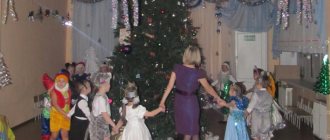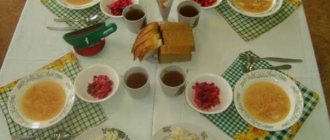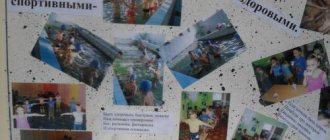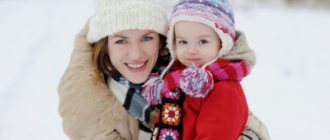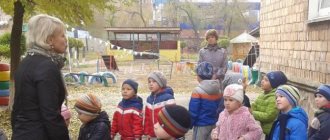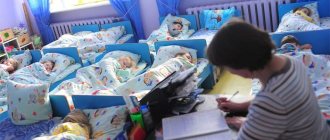Consultation "Conducting a walk in kindergarten"
Walk
Organizing and conducting walks in kindergarten.
A walk is a very important routine moment in the life of children in preschool educational institutions.
Purpose of the walk
– health promotion, fatigue prevention, physical and mental development of children, restoration of functional resources of the body reduced during activity.
Walking tasks
:
Physical development of children
– a walk is the most accessible means of hardening a child’s body, helping to increase its endurance and resistance to adverse environmental influences, especially colds.
Optimization of physical activity - while walking, children move a lot, and movements increase metabolism, blood circulation, and improve appetite. Children learn to overcome obstacles, become more agile, dexterous, courageous and resilient. They develop motor skills and abilities, strengthen the muscular system, and increase vitality.
Mental development of children -
children get a lot of new impressions and knowledge about their surroundings: about the work of adults, about transport, about traffic rules, etc. from observations they learn about the features of seasonal changes in nature, notice connections between various phenomena, and establish elementary dependencies. Observations arouse interest, questions to which they strive to find an answer. All this develops observation, expands ideas about the environment, awakens the thoughts and imagination of children.
Solving problems of moral education
– acquaintance with the hometown, its attractions, the work of adults, the importance of work for the lives of children. Familiarization with the surrounding environment helps to instill in children a love for their hometown. Kids work in the flower garden - they are taught hard work, love and respect for nature. They learn to notice her beauty. The abundance of colors, shapes, sounds in nature, their combination, repetition and variability - all this causes joyful experiences in children.
Thus, properly organized and thoughtful walks help to achieve the goals of the comprehensive development of children. Children are allowed to spend up to four hours a day outdoors. The daily routine of the kindergarten includes a daytime walk before lunch after educational activities and an evening walk after the afternoon snack. To achieve a healing effect in the summer, the daily routine provides for children to spend maximum time in the fresh air with breaks for meals and sleep.
Planning a walk.
When planning a walk, the main task of the teacher is to provide active, meaningful, varied and interesting activities for children: games, work, observations. When planning the content of a walk, the teacher provides for an even alternation of calm and motor activities of children, the correct distribution of physical activity throughout the walk. The sequence and duration of different types of activities changes taking into account specific conditions: time of year, weather, age of children and the nature of their previous activities. The content of evening walks is planned taking into account all the children’s previous activities.
Contents of children's activities during a walk. The content of children's activities during a walk depends on the time of year, weather, theme of the week, previous educational activities, interests and age.
Structure of the walk.
- Observation.
- Physical activity: outdoor games, sports games, sports exercises.
- Children's labor at the site.
- Individual work with children.
- Independent play activity.
Observation.
A large place is given to observations (pre-planned) of natural phenomena and social life. Observation can be carried out with a whole group of children, with subgroups, as well as with individual children. The teacher involves children in observations in order to develop attention and interest in nature and social phenomena. The surrounding life and nature provide an opportunity to organize interesting and varied observations. For example, you can pay attention to the clouds, their shape, color, and compare them with images known to children. Monitoring of the work of adults who work near the kindergarten, for example construction workers, should also be organized.
Physical activity. The leading place during the walk is given to games, mainly active ones. They develop basic movements, relieve mental stress, and cultivate moral qualities.
During the walk we include outdoor games:
2-3 games of high mobility;
2-3 games of low and medium mobility;
Games of children's choice.
An outdoor game can be played at the beginning of a walk if the educational activity involved children sitting for a long time. If they go for a walk after a music or physical education lesson, then the game can be played in the middle of the walk or half an hour before it ends.
The choice of game depends on the time of year, weather, air temperature.
On cold days, it is advisable to start your walk with games of high mobility associated with running, throwing, and jumping. These games help children better cope with cold weather;
In damp, rainy weather (autumn, spring), sedentary games that do not require a lot of space should be organized;
On warm spring, summer days and early autumn, games with jumping, running, throwing, and balance exercises should be played;
In hot weather, water games are played;
The use of plotless folk games with objects: ring throw, skittles; elements of sports games: gorodki, badminton, volleyball, football, hockey, etc.;
Useful games that expand children's knowledge and understanding of the environment. These are didactic games (cubes, lotto) and role-playing games (family games, astronaut games, hospital games, etc.). The teacher helps develop the plot of the game, select or create the material necessary for the game;
Outdoor games can be supplemented or replaced with sports exercises, sports games, games with elements of competition. Conduct sports entertainment. (In our kindergarten, according to the plan, physical education classes are taken outside once a week).
Labor activity of children
. The content and forms of its organization depend on the weather and
time of year.
So, in the fall, children collect flower seeds and harvests from the garden; In winter they can shovel snow and make various structures out of it.
The teacher can involve children in collecting toys and providing all possible assistance in putting things in order in the area;
It is necessary to strive to make child labor joyful, helping children to master useful skills and abilities. Labor tasks should be within the capabilities of children and, at the same time, require certain efforts from them. The teacher makes sure that they do their work well and finish what they started.
Individual work with children
. The teacher, in accordance with planning (based on the diagnostic results of children), carries out individual work on the cognitive-speech, social-personal, physical or artistic-aesthetic development of children. For example, for some he organizes games with a ball, throwing at a target, for others - balance exercises, for others, jumping off stumps, stepping over objects. Work is also carried out to develop the child’s speech: learning a nursery rhyme or a short poem, reinforcing a sound that is difficult to pronounce, etc. You can carry out art work, theatrical performances in the warm season, etc.
Each of the required components of the walk lasts from 7 to 15 minutes and is carried out against the backdrop of children’s independent activity
The teacher must guide the independent activities of children:
ensure their complete safety, teach them how to use the aids in accordance with their intended purpose, and constantly monitor their activities throughout the walk. The teacher makes sure that all the children are busy, not bored, and that no one gets cold or overheated. It attracts those children who run a lot to participate in quieter games.
The effectiveness of walks in a preschool institution is largely determined by an understanding of their significance, which consists in:
-satisfy the child’s natural biological need for movement;
- ensure the development and training of all systems and functions of the child’s body through motor activity and physical activity specially organized for this age;
-develop skills in different types of movements;
-promote the development of the child’s motor qualities and abilities;
-stimulate the functional capabilities of each child and activate children's independence;
- create optimal conditions for the versatile development of children: activation of mental activity, search for adequate forms of behavior, formation of positive emotional and moral-volitional manifestations of children.
SANPIN REQUIREMENTS FOR ORGANIZING A WALK
It is perhaps difficult to overestimate the importance of a walk in kindergarten. During a walk, children move actively, breathe fresh air, learn about the world around them, and get accustomed to work. All this is beneficial for the health, physical and mental development of children.
Sanitary standards stipulate that the daily duration of children's walks is at least 3-4 hours.
The walk is organized 2 times a day: in the first half - before lunch and in the second half - after a nap or before the children go home. When the air temperature is below -15°C and the wind speed is more than 7 m/s, the duration of the walk is reduced. The walk is not carried out at an air temperature below -15 ° C and a wind speed of more than 15 m/s for children under 4 years old, and for children 5–7 years old - at an air temperature below minus 20 ° C and a wind speed of more than 15 m/s;
During the walk, pupils are provided with physical activity and reasonable clothing depending on weather conditions, including in winter.
The reason for a child’s frequent illness cannot be directly dependent on the activities carried out in kindergarten. On the contrary, the kindergarten implements physical education and health activities aimed at strengthening the health of each child.
When organizing walks in the autumn and winter, you should:
1. Dress children in accordance with temperature conditions, avoid: - frostbite, hypothermia or overheating of the child’s body;
— getting children's clothes and shoes wet; 2. Protect children from exposure to the following dangerous factors characteristic of the autumn-winter period: - injuries during games on areas that are not cleared of snow and ice; — injuries from icicles falling from roofs, hanging blocks of snow during the thaw period; - falling from a slide, in cases where the teacher does not have insurance (provide control and direct insurance by the teacher while sliding down a slide, climbing, jumping from a hill, sports equipment, throwing); - injury: from metal or wooden stands of objects sticking out of the ground, low stumps on areas for outdoor games, injections from broken glass, dry branches, twigs on trees, bushes, splinters from sticks, boards, wooden toys, etc.; — injuries to the legs of pupils: in the presence of holes and potholes in the area, when jumping from stationary equipment without the teacher’s insurance; — injuries when sliding on an ice path; — when organizing the work of preschool children; - injuries, bruises during games with sports elements; - injuries, bruises during games on a wet and slippery surface; - injuries, bruises when sliding down ice slides, on sleds, while moving in icy conditions on slippery paths, external steps, areas not cleared of snow, ice and not sprinkled with sand; — injuries from touching metal structures with exposed parts of the body (face, hands, tongue, lips) on a frosty day; Avoid:
- infection with gastrointestinal diseases, acute respiratory infections, if the child puts dirty and cold snow or icicles in his mouth. - clear the roofs of all buildings from snow, sprinkle icicles with sand. Each teacher and all substitute teachers must teach children to recognize dangerous situations in illustrations and explain to children. Agree with the head nurse and manager about the possibility of going for a walk depending on the weather conditions and air temperature. The teacher must inspect the clothes and shoes of the pupils for compliance with weather conditions. Children should always be provided with spare things in case of bad weather, which parents bring in advance for this purpose;
Safety requirements while walking
1. It is not allowed to organize walks, work in one play area at the same time for 2 groups of pupils, the presence of parents on an evening walk 2. The teacher provides supervision, control over the calm exit of pupils from the premises and descent from the porch, do not run, do not push, when descending and ascending to the 2nd floor, hold onto the railings, do not carry large toys and objects in front of you that block the view of the path, etc.
Additional safety requirements during a walk in winter:
1. Ensure control and direct insurance by the teacher of pupils while sliding on ice paths, riding sledding;
2. Make sure that when sledding, the next child waits patiently until the child sliding in front of him reaches the end of the ramp or slide; 3. When sledding down a hill, do not allow children to sit with their backs to the slope; 4. Make sure that children do not put dirty snow or icicles in their mouths; 5. If frost and wind become stronger, take children to the kindergarten premises; Safety requirements in situations during a walk:
1. All employees temporarily replacing the teacher in the group take on the functions of rescuing children.
2. If unforeseen situations arise, it is necessary to: - ensure the safety of children; — make sure there is no dangerous situation; — inform the administration about the incident, provide first aid in case of an accident; — notify the rescue service by phone if the situation requires it. Safety requirements at the end of the walk
1. Organize a calm entry of pupils into the kindergarten premises (the 1st subgroup passes and undresses under the supervision of an assistant teacher, the 2nd - under the supervision of a teacher). 2. Clean students’ outer clothing and shoes from snow, dirt, and sand. 3. Check how the students put their clothes in the lockers. If necessary, change the pupils into dry clothes and underwear. 4. Organize hygiene procedures: visiting the toilet, washing hands with soap. 5. Ensure drying of wet clothes and shoes after rain or in winter
Types of walks in kindergarten
1. At the venue:
• on the territory of the kindergarten;
• outside the territory of the kindergarten (possible in older groups, over short distances).
2. By content:
• traditional, which includes children’s work activities (cleaning up leaves, snow, etc.), active and quiet games, etc.;
• thematic: consisting of observations and conversations on a specific topic (animals, clouds, trees, city transport, etc.), can be a street theater performance, a quest with overcoming simple obstacles - requires a pre-prepared script;
• targeted: organized exit outside the territory of the kindergarten, over a short distance (up to 2 km);
• excursion (usually a museum tour): once a month, starting from the middle group;
• hike: can be carried out 1-2 times a year in older groups.
Conclusion.
So, the process of raising children is continuous. Great potential opportunities for the comprehensive harmonious development of a child’s personality are inherent in the process of educational work with children in a walking environment. Here, like nowhere else, children are provided with unique conditions for all-round development; their needs for active movements, independent actions when getting to know the world around them, new vivid impressions, and free play with both natural materials and toys are fully satisfied. However, due to age characteristics, children themselves cannot use all the walking time with maximum benefit for their development. An adult must pedagogically correctly guide their activities.
In the process of daily outdoor games and physical exercises during walks, children’s motor experience expands and their existing skills in basic movements are improved; agility, speed, endurance develop; independence, activity, positive relationships with peers are formed
Walking is like medicine. Rehabilitation doctor on how to walk correctly
The trend towards a healthy lifestyle is attracting more and more fans. What are the features of healthy walks in the off-season? “AiF” talked about an effective method of recovery in urban conditions with the famous rehabilitation doctor, candidate of medical sciences, head of the clinic Alexander Shishonin .
Yulia Borta, AiF.ru: Alexander Yuryevich, what weather and when is it better to go for a walk?
Alexander Shishonin : Walking should not depend on the weather if a person decides to take care of his health. This is a very correct decision, especially since walking is one of the oldest and most effective tools for the general health of our body. And in order to get the maximum effect from classes, you need to walk at least an hour a day, every day, six times a week with one day of rest. And in terms of the pace of walking, it should not be a calm walk, but walking at an increased pace, about 15-20% higher than a walking step. For a person of average height this is 5-6 km per hour. At this pace it will already be a good physical activity. And the weather shouldn't stop you. On the contrary, the more extreme it is, the more pronounced the effect of the exercise will be. So, for example, if the weather is warm, then the vascular system will exercise more, if it is cold, windy, the immune system will be stimulated. Therefore, the variety of weather and the change of seasons are very beneficial for our body. It seems like the walking is the same, but the effect you get is different.
Article on the topic
Pedal. Is cycling always good for your health?
— I heard that a temperature of 5-7 degrees for walking is the most beneficial
— I agree with this opinion if we are talking about walking quickly and for a long time, so that the body does not become hypothermic. There is an explanation for this: when a person actively walks for a long time in cool weather, he produces ATP (adenosine triphosphate), which is important for humans and is a universal source of energy for all biochemical processes. It is produced in reserve, since the body does not know how much we will walk and expend energy. The body also begins to absorb oxygen more efficiently, mitochondria begin to work at full capacity, a supply of ATP is produced, and free radical stress decreases. If the ambient temperature is low, then ATP energy does not need to be spent on cooling the body, and it switches free energy to restoration processes inside the body. This energy will be used to produce new young stem cell elements, the body will renew and rejuvenate.
— How to dress correctly, should you wrap yourself up, when should you put on a hat?
— A Siberian is not the one who doesn’t freeze, but the one who dresses warmly. If you are going on a health walk to improve your health, then dress for the weather. But considering that you will walk 15-20% faster than with normal walking, you need to dress 15-20% lighter.
There is no need to wear a hat. I believe that a hat is only needed in windy weather to prevent hypothermia of the respiratory system.
The myth of 10 thousand steps. How many kilometers should you walk in a day? More details
— What to do if your hands are cold, even when it’s not too cold?
— If your hands are cold, this is a symptom that indicates a general lack of blood circulation, weakness of the vascular system. Walking trains the entire vascular system, and this unpleasant symptom will go away over time, with regular walking for a month. And even in winter your hands will not freeze. For example, I never wear gloves in winter.
Question answer
Why is running in the cold dangerous for your health?
— Is it worth going for a walk in bad weather or is it better to stand on the balcony?
— The weather should not be an obstacle to a person’s health. You have a goal, you are looking for health. People go to work in any weather, but here the goal is very important - health!
— What exercises can you recommend in the fresh air?
- In the fresh air, it is better to do what our body is designed to do - walk. The exercises require maximum concentration of attention on correct execution in order to achieve the desired effect. If the weather allows, you can do pull-ups, bends and other exercises known to everyone.
